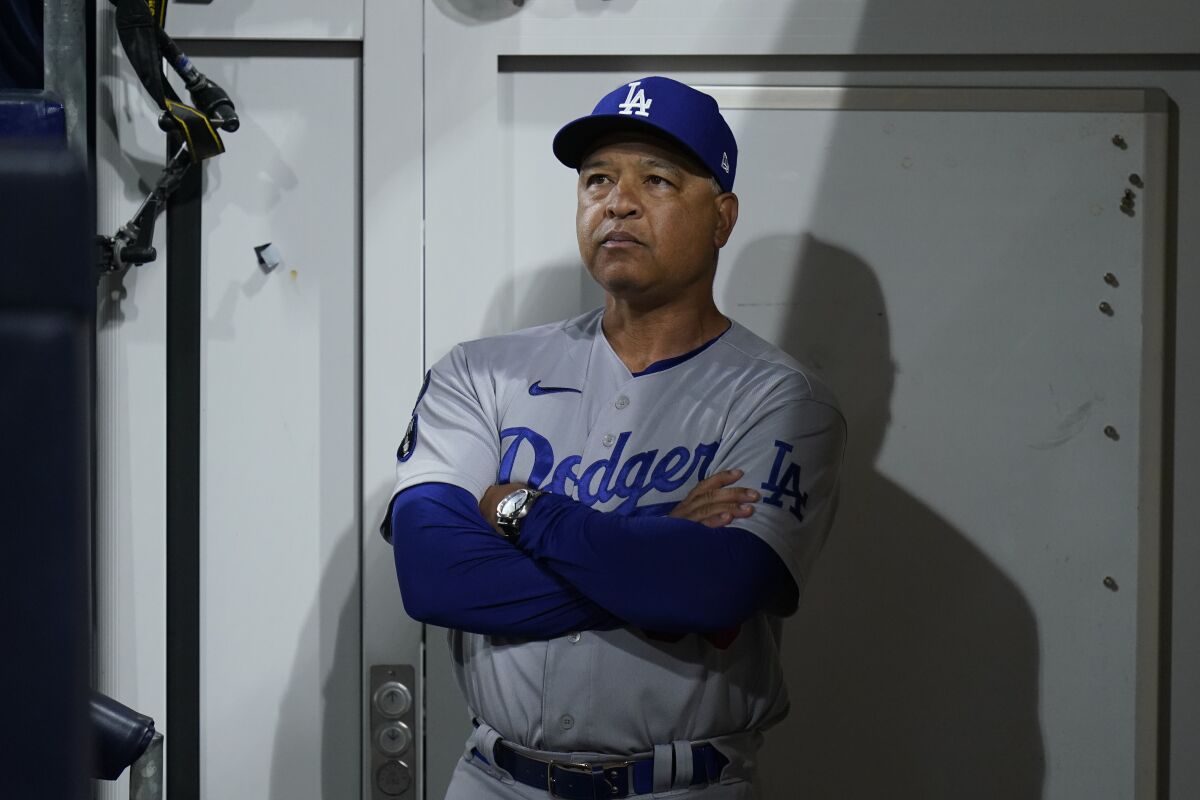Hernández: Blame Andrew Friedman’s roster construction, pitcher strategy for Dodgers’ collapse
The temptation will be to blame Dave Roberts for what happened to the Dodgers on Saturday night.
Roberts is their on-field decision maker. He certainly deserves his share of criticism for the demise of his 111-win team.
The nightmare that unfolded on Saturday night at Petco Park, however, points to an issue beyond the reach of Roberts’ office.
The problem here is with the Dodgers’ organizational philosophy, specifically with how Andrew Friedman views pitchers and how they should be used.
By limiting the responsibilities of his starting pitchers, Friedman has effectively called on his relievers to cover more and more innings. But if every pitching change Roberts makes is an opportunity to produce favorable matchups, it’s also a chance for something to go wrong.
This was the inherent danger in how Friedman constructed this roster.
Consider the sequence of events that resulted in the come-from-ahead 5-3 defeat to the San Diego Padres in Game 4 of the National League Division Series that ended the Dodgers’ season.
Tyler Anderson hadn’t given up a run but was yanked from the game after just five innings with the Dodgers leading, 2-0. Anderson is a left-hander and the left-handed-hitting Juan Soto was up first in the sixth inning, but no matter.
Decisions like this are often formulated before games with the guidance of the front office. A call was likely made before the game to not let Anderson pitch to Soto for a third time.
The consequence of this was that Roberts would have to make pitching change after pitching change over the last four innings of the game, each call to the bullpen representing a potential landmine.
The strategy wasn’t limited to just Game 4.
Julio Urias pitched only five innings in Game 1. Clayton Kershaw was taken out of the same point of Game 2. The Dodgers resorted to a bullpen game in Game 3 in which starter Tony Gonsolin registered only four outs; relievers had to cover the final 6 2/3 innings.
Roberts hadn’t made any obviously bad choices through the first three games. But it was only a matter of time that he would. This is the nature of baseball. Relievers aren’t starters because they’re not good enough. Outside of a lights-out closer, turn to any reliever enough times and he’s bound to fail.

Dodgers manager Dave Roberts looks on before Game 4 of the NLDS on Saturday.
(Jae C. Hong / Associated Press)
Which is exactly what happened.
Chris Martin gave the Dodgers a scare in the sixth, as he gave up an infield hit to Jake Cronenworth that advanced Brandon Drury to second base. Martin escaped the jam by striking out Will Myers.
Disaster struck in the next inning.
With the Dodgers now ahead by three runs, Roberts placed the game in the hands of Tommy Kahnle.
Kahnle walked Jurickson Profar, who reached third on a single to right-center field by Trent Grisham.
Catcher Austin Nola drove in Profar with a single.
Kahnle was replaced by Yency Almonte, who didn’t fare much better.
Ha-Seong Kim doubled to drive in Grisham. Soto followed with a single that scored Nola and tied the game, 3-3.
Almonte regrouped to get two quick outs, but Roberts made another pitching change, this one which completed the comeback.
Left-hander Alex Vesia was summoned to pitch to the left-handed-hitting Cronenworth, who drove in two runs that moved the Padres in front, 5-3.
Whatever the state of their pitching, the Dodgers shouldn’t have lost to the Padres. That’s not what cost the Dodgers this series. What cost them the series was that they didn’t get much production out of Mookie Betts, Trea Turner and Freddie Freeman until Game 4.
Still, what the defeat exposed was that the Dodgers never had the pitching to win a World Series. Their model was unsustainable.
The Dodgers could have beaten the Padres like this. They might have even been able to beat the Philadelphia Phillies like this. But the Houston Astros or New York Yankees?
Injuries will provide Friedman with an alibi.
Walker Buehler was in a Fox studio in Los Angeles, sidelined for the season as he recovered from reconstructive elbow surgery. One-time Cy Young Award candidate Gonsolin suffered a late-season injury, relegating him to an abbreviated start in a bullpen game in a Game 3 loss. Dustin May also went down late in the season, which moved him into a relief role.
Whether the Dodgers erred by not reinforcing their rotation or more seriously pursuing Juan Soto at the trade deadline – or both – they face the prospect of a closing window.
Turner will be a free agent this winter.
Freeman will turn 34 next season. Betts will turn 31.
Freeman is signed through 2027 and Betts through 2032. This creates a dynamic the Dodgers haven’t yet encountered under Friedman, as they will have well over $50 million tied up annually in two aging players.
Years from now, they could be looking back at this season as a wasted opportunity.
For more latest Education News Click Here

